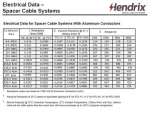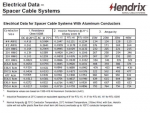Trying to get a handle on how to interpret 1 KV+ NEC requirements for overcurrent protection.
First, 215.3 seems pretty clear when it states, "Feeders shall be protected against overcurrent in accordance with the provisions of Part I of Article 240. Where a feeder supplies continuous loads or any combination of continuous and noncontinuous loads, the rating of the overcurrent device shall
not be less than the noncontinuous load plus 125 percent of the continuous load.". That seems pretty cut and dry. But then exception #2 reads, "Feeders over 1000 volts, nominal, shall comply with Part IX of Article 240". So the very first immediate question here is do feeders over 1,000 Volts need to comply with BOTH Part I and Part IX? In other words, is Part I the general rule and Part IX provides modifications to Part I, or do I apply Part IX exclusively and simply ignore Part I?
Second question. Article 240.100(C) requires: "(C) Conductor Protection. The operating time of the protective device, the available short-circuit current, and the conductor used shall be coordinated to prevent damaging or dangerous temperatures in conductors or conductor insulation under short circuit conditions." Yet just above it in 240.101(A) just below it, a fuse continuous rating cannot exceed 300% of the ampacity and the long term trip setting of a breaker cannot exceed 600% of the ampacity.
This latter section is the source of my confusion in general. Because if I use 300% rated fuses or 600% rated breaker relays, then clearly although there is some short circuit protection, there clearly isn't any "overload" protection at all. This is nothing like the "100% of noncontinuous load + 125% of continuous load" rule arising out of Article 215.3 which other than the laundry list of exceptions in 240.4(A) through (G) is both very easy to understand seems very logical.
If I read Part IX as a purely prescriptive standard then I can set breakers to 600% of ampacity and fuses to 300% of ampacity. This flies in the face of good engineering sense though. So my best understanding would be that 240.100(C) applies first and foremost, reading from the general to the specific. 240.101(A) is almost extraneous because it is superceded by 240.100(C). My best guess here is that the laundry list of exceptions in 240.4(A) through (G) from Part I is not used in Part IX. Instead it's somewhat of an "open ended" or performance based standard. This for instance allows a common practice to use 300% continuous rating E-rated fuses to protect transformers while avoiding inrush which makes them good for short-circuit protection only, and supply overload protection via protection on the secondary side of the transformer. The overload protection is downstream of the conductor being protected.
The only other logical interpretation that I can think of otherwise is that the intent of Part IX is to provide short circuit protection only under the assumption that generally speaking overload conditions are more of a concern on branch circuits and low voltage systems compared to medium voltage systems and thus Code only requires short circuit protection.
Other Codes (e.g. IEEE Red book, Buff book) take the approach that protection from damage is the goal but since these are engineering guides and not Codes with regulatory force, it's just not the same. And either way the way that I've always done this is to look at the damage curves of the conductors and adjust the relay settings to accommodate both the damage curve and coordination, and if I have to choose between damage and coordination, damage takes priority over miscoordination. This issue becomes most prevalent when working with fuses over breakers where quite often the very fast opening time for short circuits causes the fuse to miscoordinate with the breaker. The only other choice would be lack of short circuit protection for the circuit even if it coordinates well, or replacing the fuse with a slower device.
Anyone familiar with this enough to shed some light on it? A very old Mike Holt article that was published in EC&M gives a very good overview of the overcurrent setting rules but only covers low voltage and not medium voltage rules.
First, 215.3 seems pretty clear when it states, "Feeders shall be protected against overcurrent in accordance with the provisions of Part I of Article 240. Where a feeder supplies continuous loads or any combination of continuous and noncontinuous loads, the rating of the overcurrent device shall
not be less than the noncontinuous load plus 125 percent of the continuous load.". That seems pretty cut and dry. But then exception #2 reads, "Feeders over 1000 volts, nominal, shall comply with Part IX of Article 240". So the very first immediate question here is do feeders over 1,000 Volts need to comply with BOTH Part I and Part IX? In other words, is Part I the general rule and Part IX provides modifications to Part I, or do I apply Part IX exclusively and simply ignore Part I?
Second question. Article 240.100(C) requires: "(C) Conductor Protection. The operating time of the protective device, the available short-circuit current, and the conductor used shall be coordinated to prevent damaging or dangerous temperatures in conductors or conductor insulation under short circuit conditions." Yet just above it in 240.101(A) just below it, a fuse continuous rating cannot exceed 300% of the ampacity and the long term trip setting of a breaker cannot exceed 600% of the ampacity.
This latter section is the source of my confusion in general. Because if I use 300% rated fuses or 600% rated breaker relays, then clearly although there is some short circuit protection, there clearly isn't any "overload" protection at all. This is nothing like the "100% of noncontinuous load + 125% of continuous load" rule arising out of Article 215.3 which other than the laundry list of exceptions in 240.4(A) through (G) is both very easy to understand seems very logical.
If I read Part IX as a purely prescriptive standard then I can set breakers to 600% of ampacity and fuses to 300% of ampacity. This flies in the face of good engineering sense though. So my best understanding would be that 240.100(C) applies first and foremost, reading from the general to the specific. 240.101(A) is almost extraneous because it is superceded by 240.100(C). My best guess here is that the laundry list of exceptions in 240.4(A) through (G) from Part I is not used in Part IX. Instead it's somewhat of an "open ended" or performance based standard. This for instance allows a common practice to use 300% continuous rating E-rated fuses to protect transformers while avoiding inrush which makes them good for short-circuit protection only, and supply overload protection via protection on the secondary side of the transformer. The overload protection is downstream of the conductor being protected.
The only other logical interpretation that I can think of otherwise is that the intent of Part IX is to provide short circuit protection only under the assumption that generally speaking overload conditions are more of a concern on branch circuits and low voltage systems compared to medium voltage systems and thus Code only requires short circuit protection.
Other Codes (e.g. IEEE Red book, Buff book) take the approach that protection from damage is the goal but since these are engineering guides and not Codes with regulatory force, it's just not the same. And either way the way that I've always done this is to look at the damage curves of the conductors and adjust the relay settings to accommodate both the damage curve and coordination, and if I have to choose between damage and coordination, damage takes priority over miscoordination. This issue becomes most prevalent when working with fuses over breakers where quite often the very fast opening time for short circuits causes the fuse to miscoordinate with the breaker. The only other choice would be lack of short circuit protection for the circuit even if it coordinates well, or replacing the fuse with a slower device.
Anyone familiar with this enough to shed some light on it? A very old Mike Holt article that was published in EC&M gives a very good overview of the overcurrent setting rules but only covers low voltage and not medium voltage rules.



